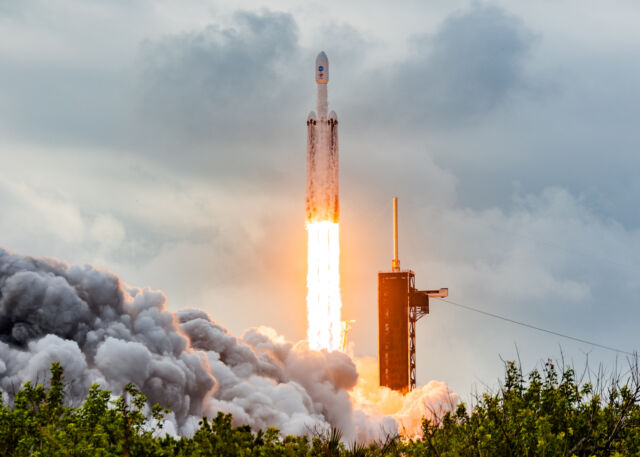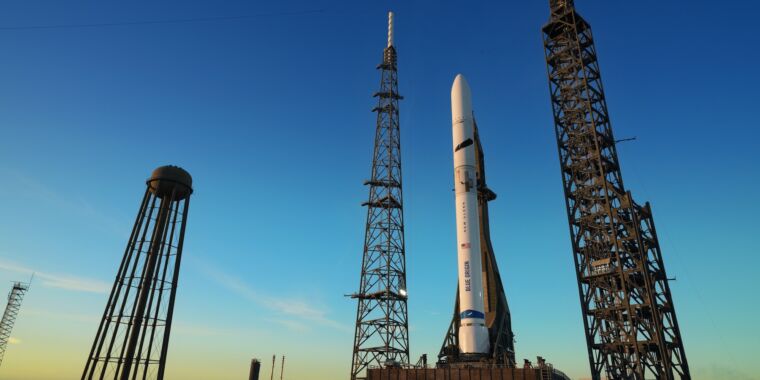After years of lobbying, protests and bidding, Jeff Bezos’s space company is now a military launch contractor.
The US Space Force announced Thursday that Blue Origin will compete with United Launch Alliance and SpaceX for at least 30 military launch contracts over the next five years. These launch contracts have a combined value of up to $5.6 billion.
This is the first of two major contract decisions the Space Force will make this year as the military seeks to foster more competition among its roster of launch providers, and reduce its reliance on just one or two companies.
For more than a decade following its formation from the merger of Boeing and Lockheed Martin rocket programs, ULA was the sole company certified to launch the military’s most critical satellites. This changed in 2018, when SpaceX started launching national security satellites for the military. In 2020, despite protests from Blue Origin seeking eligibility, the Pentagon selected ULA and SpaceX to continue sharing launch duties.
The National Security Space Launch (NSSL) program is in charge of selecting contractors to deliver military surveillance, navigation, and communications satellites into orbit.
Over the next five years, the Space Force wants to tap into new launch capabilities from emerging space companies. This procurement approach for this new round of contracts, known as NSSL Phase 3, is different from the way the military previously bought launch services. Instead of grouping all national security launches into one monolithic contract, the Space Force is dividing them into two classifications: Lane 1 and Lane 2.
The Space Force’s contract announced Thursday was for Lane 1, which is for less demanding missions to low-Earth orbit. These missions include smaller tech demos, experiments, and launches for the military’s new constellation of missile tracking and data relay satellites, an effort that will eventually include hundreds or thousands of spacecraft managed by the Pentagon’s Space Development Agency.
This fall, the Space Force will award up to three contracts for Lane 2, which covers the government’s most sensitive national security satellites, which require “complex security and integration requirements.” These are often large, heavy spacecraft weighing many tons and sometimes needing to go to orbits thousands of miles from Earth. The Space Force will require Lane 2 contractors to go through a more extensive certification process than required in Lane 1.
“Today marks the beginning of this innovative, dual-lane approach to launch service acquisition, whereby Lane 1 serves our commercial-like missions that can accept more risk and Lane 2 provides our traditional, full mission assurance for the most stressing heavy-lift launches of our most risk-averse missions,” said Frank Calvelli, assistant secretary of the Air Force for space acquisition and integration.
Meeting the criteria
The Space Force received seven bids for Lane 1, but only three companies met the criteria to join the military’s roster of launch providers. The basic requirement to win a Lane 1 contract was for a company to show their rocket can place at least 15,000 pounds of payload mass into low-Earth orbit, either on a single flight or over a series of flights within a 90-day period.
The bidders also had to substantiate their plan to launch the rocket they proposed to use for Lane 1 missions by December 15 of this year. A spokesperson for Space Systems Command said SpaceX proposed using their Falcon 9 and Falcon Heavy rockets, and ULA offered its Vulcan rocket. Those launchers are already flying. Blue Origin proposed its heavy-lift New Glenn rocket, slated for an inaugural test flight no earlier than September.
“As we anticipated, the pool of awardees is small this year because many companies are still maturing their launch capabilities,” said Brig. Gen. Kristin Panzenhagen, program executive officer for the Space Force’s assured access to space division. “Our strategy accounted for this by allowing on-ramp opportunities every year, and we expect increasing competition and diversity as new providers and systems complete development.”

Trevor Mahlmann/Ars Technica
The Space Force plans to open up the first on-ramp opportunity for Lane 1 as soon as the end of this year. Companies with medium-lift rockets in earlier stages of development, such as Rocket Lab, Relativity Space, Firefly Aerospace, and Stoke Space, will have the chance to join ULA, SpaceX, and Blue Origin in the Lane 1 pool at that time. The structure of the NSSL Phase 3 contracts allow the Pentagon to take advantage of emerging launch capabilities as soon as they become available, according to Calvelli.
In a statement, Panzenhagen said having additional launch providers will increase the Space Force’s “resiliency” in a time of increasing competition between the US, Russia, and China in orbit. “Launching more risk-tolerant satellites on potentially less mature launch systems using tailored independent government mission assurance could yield substantial operational responsiveness, innovation, and savings,” Panzenhagen said.
More competition, theoretically, will also deliver lower launch prices to the Space Force. SpaceX and Blue Origin rockets are partially reusable, while ULA eventually plans to recover and reuse Vulcan main engines.
Over the next five years, Space Systems Command will dole out fixed-price “task orders” to ULA, SpaceX, and Blue Origin for groups of Lane 1 missions. The first batch of missions up for awards in Lane 1 include seven launches for the Space Development Agency’s missile tracking mega-constellation, and a task order for the National Reconnaissance Office, the government’s spy satellite agency. However, military officials require a rocket to have completed at least one successful orbital launch to win a Lane 1 task order, and Blue Origin’s New Glenn doesn’t yet satisfy this requirement.
The Space Force will pay Blue Origin $5 million for an “initial capabilities assessment” for Lane 1. SpaceX and ULA, the military’s incumbent launch contractors, will each receive $1.5 million for similar assessments.
ULA, SpaceX, and Blue Origin are also the top contenders to win Lane 2 contracts later this year. In order to compete in Lane 2, a launch provider must show it has a plan for its rockets to meet the Space Force’s stringent certification requirements by October 1, 2026. SpaceX’s Falcon 9 and Falcon Heavy are already certified, and ULA’s Vulcan is on a path to achieve this milestone by the end of this year, pending a successful second test flight in the next few months. A successful debut of New Glenn by the end of this year would put the October 2026 deadline within the reach of Blue Origin.

